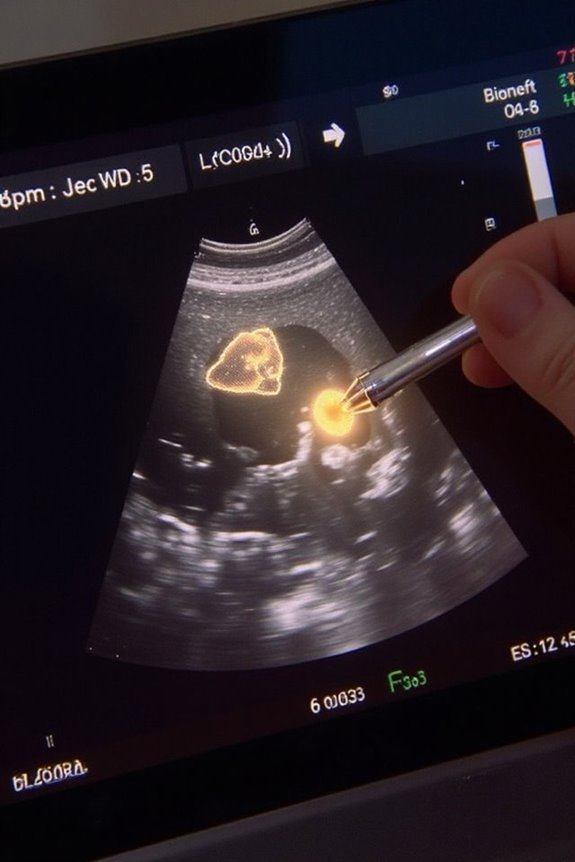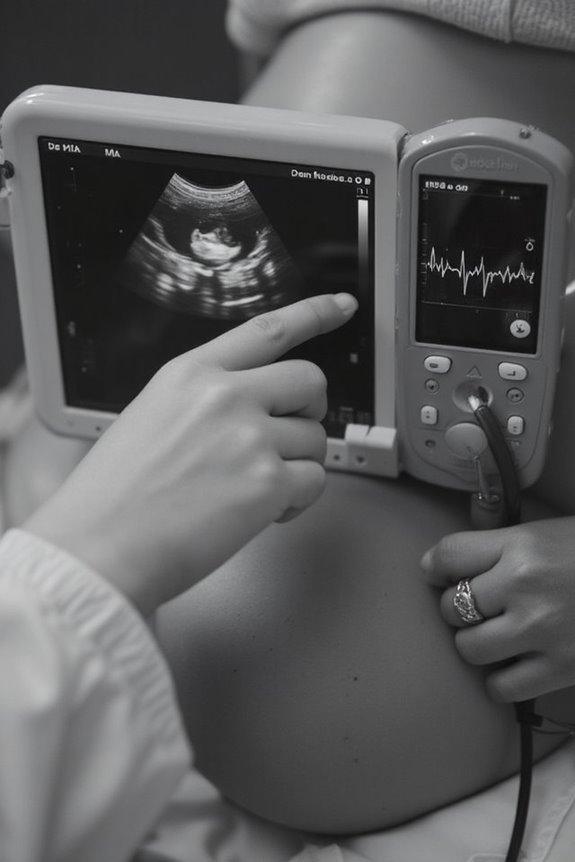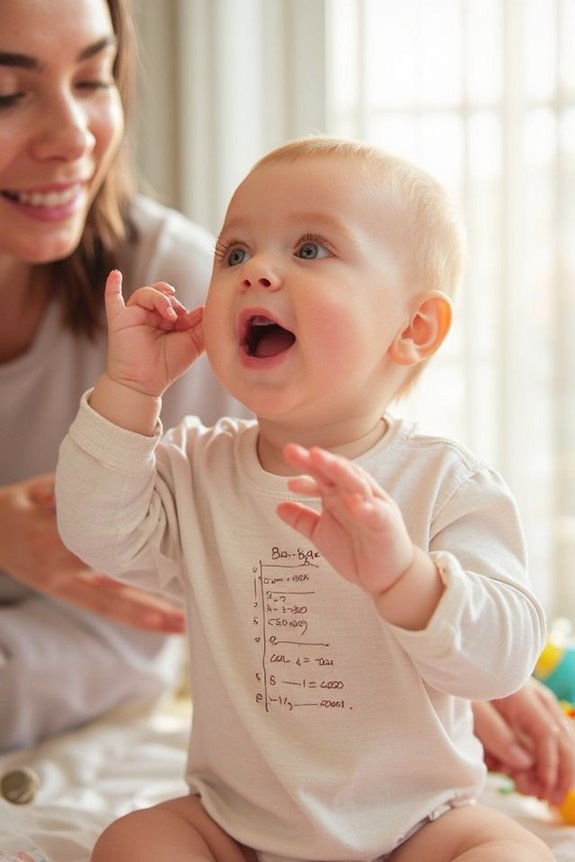A baby’s heart begins developing around the third week after fertilization. The first contractions start by day 21, with an initial rate of 75-80 beats per minute. Using modern transvaginal ultrasound technology, cardiac activity can typically be detected between 5-6 weeks gestation, appearing as a flickering motion. The heart rate increases rapidly, peaking at 140-170 bpm by week nine before stabilizing between 110-160 bpm after week 13. Understanding these cardiac milestones helps track healthy development.
Key Takeaways
- Cardiac development begins at approximately 3 weeks after fertilization.
- The first heart contractions start by day 21 post-conception.
- Initial heartbeat is detectable via ultrasound at 5-6 weeks gestation.
- Heart rate begins at 75-80 beats per minute and increases throughout early pregnancy.
- By 6 weeks, cardiac activity can be visualized as a flickering motion with transvaginal ultrasound.
The Early Stages of Fetal Cardiac Development
The heart’s journey begins remarkably early in pregnancy, with the first stages of cardiac development initiating around the third week after fertilization. During this critical period, cardiac precursor cells gather to form the primitive heart tube—the foundation of this essential organ.
By day 21, this tube begins its first contractions, making the heart the first functioning organ in the developing embryo. These initial beats occur because cardiac myocytes (heart muscle cells) spontaneously generate electrical impulses.
The early heartbeat begins at a rate similar to the mother’s—about 75-80 beats per minute. As the primitive heart tube elongates and folds into an S-shape between days 23-28, it creates the blueprint for the four-chambered heart that will develop by week 7.
First Detection: When Can We See a Heartbeat?

Modern medical technology now allows us to detect a baby’s heartbeat remarkably early in pregnancy. Using transvaginal ultrasound, I can often identify cardiac activity as early as 5-6 weeks gestation, sometimes even at 34 days.
The earliest heartbeat detection requires specialized equipment:
- High-frequency transvaginal ultrasound (more sensitive than transabdominal)
- High-resolution imaging technology
- Skilled ultrasound technicians
What to know about early heartbeats:
- First appears as flickering motion
- Initially slow, increasing as pregnancy progresses
- Visible when the fetal pole measures just 1-2 mm
This early detection is essential for evaluating fetal viability. If a crown-rump length reaches ≥7 mm without a heartbeat, it may indicate concerns requiring follow-up evaluation with repeat scans.
Heart Rate Patterns Throughout Pregnancy

As your baby develops in the womb, their heartbeat undergoes fascinating changes that I’ll track throughout your pregnancy.
The initial heartbeat starts around week five at 80-85 beats per minute (bpm) and rapidly increases by about 3 bpm daily during the first month. By week nine, it peaks at 140-170 bpm with a distinctive “galloping” rhythm. After week 13, the rate stabilizes between 110-160 bpm, where it generally remains until birth.
Various monitoring techniques help track these patterns:
- Electronic fetal monitoring (EFM) measures heart rate variability
- Ultrasounds detect abnormal patterns early
- Continuous monitoring in later pregnancy assesses well-being
Watch for these potential concerns:
- Tachycardia: heart rate above normal range
- Bradycardia: heart rate below normal range
- Late decelerations: may indicate distress
Ultrasound Technology and Heartbeat Monitoring

How early can we detect your baby’s heartbeat? With today’s advanced technology, I can typically detect cardiac activity as early as 6 weeks using high-frequency transvaginal ultrasound. By 7 weeks, standard ultrasound equipment reliably shows this significant milestone.
Recent ultrasound advancements have revolutionized heartbeat monitoring:
- Modern Doppler devices provide real-time visual and audio monitoring
- 3D/4D imaging creates detailed views of your baby’s developing heart
- AI-assisted analysis improves accuracy in detecting potential issues
- Transvaginal probes offer the earliest possible detection (34 days gestation)
Non-ultrasound alternatives are also emerging, including:
- Fetal magnetocardiography (fMCG)
- Transabdominal ECG monitoring
- Vibration sensing systems
These technologies not only confirm your baby’s heartbeat but can identify rhythm patterns and potential concerns earlier than ever before.
Key Milestones in Heart Formation

While ultrasound technology helps us see your baby’s heartbeat, understanding the remarkable development that precedes this moment provides valuable context.
The journey begins with heartbeat initiation at just 21-22 days after fertilization, when the heart starts beating at 75-80 BPM—similar to your own rate. During this same period, the heart tube forms as the foundation for your baby’s developing cardiovascular system.
By weeks 3-4, dramatic changes occur:
- Heart tube folds into an S-shape
- Looping positions future chambers correctly
- Septation begins, separating heart chambers
The heart rate accelerates to 165-185 BPM around week 7 before gradually decreasing to about 145 BPM by term. Throughout this process, the heart continues to mature while supporting your growing baby’s needs.
Factors That Affect Early Heartbeat Detection
Detecting your baby’s heartbeat represents a significant milestone in pregnancy, though several factors can influence when this detection occurs. Early gestational challenges include the tiny size of the developing heart and your baby’s position within the womb.
Maternal health factors play an essential role in detection timing:
- Body composition – increased maternal body fat can interfere with Doppler signals
- Uterine position – a tilted uterus may complicate heartbeat detection
- Chronic conditions like hypertension or diabetes
Technical limitations also affect detection:
- Quality of ultrasound equipment
- Technician expertise
- Environmental interference
Your healthcare provider will consider these variables when scheduling your first heartbeat detection appointment, typically between 6-12 weeks depending on the method used. Remember that detection timing varies widely among pregnancies and doesn’t necessarily indicate problems.
The Clinical Importance of Cardiac Activity
Early cardiac activity serves as a vital indicator of your baby’s development and overall health during pregnancy. The heart begins beating approximately 22 days after conception, making it the first functioning organ in your baby’s body.
The clinical importance of this early cardiac activity cannot be overstated:
- Prenatal assessment tools like fetal echocardiography can detect congenital heart disease during pregnancy
- Early detection allows medical teams to plan appropriate interventions
- Fetal heart rate monitoring provides essential information about your baby’s well-being
- By the tenth week, your baby’s heart has developed into a four-chambered organ
When cardiac abnormalities are identified early, healthcare providers can better prepare for delivery and postnatal care, greatly improving outcomes for babies with heart conditions.
Frequently Asked Questions
Can Stress Affect the Development of a Baby’s Heartbeat?
Yes, I believe stress can have an impact on fetal development generally, though research on its direct effects on heartbeat formation is limited. I’d recommend stress management techniques during pregnancy for overall maternal-fetal health.
Is a Fetal Heartbeat Detectable at Home Without Medical Equipment?
Like listening for a whisper in the wind, home detection of a fetal heartbeat without equipment is challenging. I’d recommend waiting until 18-20 weeks when you might hear it with a stethoscope for heartbeat monitoring.
Do Twins Develop Heartbeats at the Same Time?
Yes, twins develop heartbeats at the same time, following the identical timeline as single babies. I can confirm that twin development includes simultaneous heartbeat formation, typically beginning around week 5 of pregnancy.
Can the Fetal Heartbeat Predict the Baby’s Gender?
Clear as crystal, I’m here to bust heartbeat myths: No, a baby’s heartbeat cannot predict gender. Despite popular gender prediction folklore, research shows no correlation between heart rates and whether you’re having a boy or girl.
Does Maternal Heart Rate Influence Fetal Heart Development?
I don’t see direct evidence that my heart rate influences fetal heart development, but my overall maternal health does impact fetal circulation. Conditions affecting my cardiovascular system could indirectly affect my baby’s developing heart.
References
https://www.medicalnewstoday.com/articles/when-does-a-fetus-have-a-heartbeat
https://my.clevelandclinic.org/health/articles/7247-fetal-development-stages-of-growth
https://www.babycenter.com/pregnancy/your-baby/fetal-development-your-babys-heart_20005022
https://www.thebump.com/a/when-does-fetus-have-heartbeat
https://lozierinstitute.org/fetal-development/week-6/
https://teachmeanatomy.info/the-basics/embryology/cardiovascular-system/
https://open.oregonstate.education/aandp/chapter/19-5-development-of-the-heart/
https://en.wikipedia.org/wiki/Heart_development
https://karger.com/fdt/article/47/5/373/136983/The-Transitional-Heart-From-Early-Embryonic-and
https://pubmed.ncbi.nlm.nih.gov/8694073/





